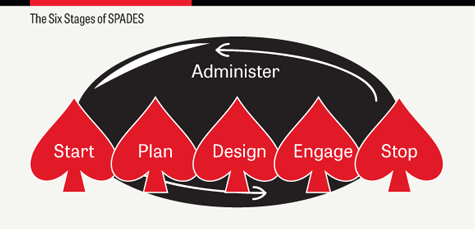TD Magazine Article
Training in SPADES
Infuse instructional design methods with practical project management principles.
Sat Jun 08 2013
Bookmark

I was fooling myself. I truly believed my training and development projects were successful. However, "successful" meant something different for me than it did for my sponsors. I missed a few deadlines or went over budget, but as long as I met my learning objectives I didn't concern myself. It wasn't working.
Later, I discovered project management concepts and slowly started weaving them into my daily work. I quickly found that while I still met my learning objectives, I also met my deadlines and budgets.
Instructional design processes
We all have our favorite instructional design methods. Most of us use ADDIE in some form or another. However, I pose that ADDIE, or any instructional system design (ISD) model by itself, is inherently incomplete.
As workplace learning professionals, we are expected to create more than just a learning experience. If we are focused only on our learners, we are shortsighted.
We must manage our training initiatives the same way our other business partners manage their initiatives. We must learn to incorporate more project management into our daily work.
Project management
Project management refers to the skill sets of managing a team of individuals and resources to create a specific deliverable. Projects have a defined start and end point. They have budgets, teams, and managers. Creating a specific learning solution and delivering it to an audience fits the definition of a project.
We all want a seat at the table, and to achieve that we must speak their language. We must talk in terms of timelines, budgets, and resources and not just learning objectives. We must achieve our learning objectives, but we also must complete projects on time and on budget.
The Project Management Institute (PMI) breaks down project management into five process groups and 10 knowledge areas.
The five process groups are initiation, planning, executing, monitoring and controlling, and closing. Some may be larger or smaller, but each should always occur on every project. This ensures that projects are set up and planned correctly, managed along the way, and then completely closed.
PMI's 10 knowledge areas are integration, scope, time, cost, quality, human resources, communications, risk, procurement, and stakeholders. These areas are designed to categorize the various tasks typically performed during a project.
Not all projects warrant all of the knowledge areas. For example, if the project requires no procurement, there will be few or no tasks required, so that knowledge area may not be used.
Although we should incorporate more project management techniques into our daily work, we can't rely on project management techniques alone to create a successful learning solution. The use of SPADES blends together the concepts from ADDIE along with the best practices from project management to create a winning combination.
Putting project management into ISD
SPADES stands for start, plan, administer, develop, engage, and stop. Each of these stages incorporates tasks typically completed with ADDIE, but adds project management techniques to ensure everyone's needs are met.
Since every training solution is different, you may not need all of the various tasks in each stage. However, every project should go through each stage to some degree.
Start
Lay the foundation of your project and complete critical tasks. One of the first steps is to get a clear understanding of who has a stake in your project's outcome. This will obviously include the training team and the learners, but think beyond the standard audience.
Does your boss have an interest? How about the learners' bosses? Do the learners interact with another customer or could this training initiative change something in how the learners interact with another group? Will your project use someone else's resources (for example, subject matter experts)?
Each of these people is a stakeholder. They all have an interest, or stake, in how your project moves forward and the result it creates.
The start phase also includes a needs analysis in which you determine what kind of gaps you are attempting to solve and how it will be measured. These results become a part of the project's measurements of success.
Plan
During the critical planning phase, take stock of the tasks your team will need to accomplish and the resources required to complete them. For the right projects, project managers will create detailed plans for tasks, communications, budgets, risks, procurements, and resources.
Task plans help you to build your schedule and determine how long it will take. Knowing this is important because you may have a requirement to complete a project in three months but your plan tells you it will take four.
If you have a good plan, you know in advance that you need more time and this helps to maintain a relationship with a stakeholder so you aren't missing a deadline later. Task plans consider not only the amount of time, but also the resources you will need.
Training solutions often rely on SMEs to provide content and direction. Task plans help you understand when you are going to need time from the SMEs so they are better able to plan their involvement. Having a clear plan helps you know what needs to happen and
allows you to adapt if something doesn't go according to plan.
Administer
Administration involves tasks that can occur at any point in the training project. A prime example would be communicating.
Project managers spend a majority of their time communicating with the project team, as well as stakeholders, users, suppliers, and resources. Project managers should take time to understand what kind of communication expectations each person has. This helps to understand if you need to create a weekly status report or if a less formal verbal update is appropriate.
This also is where the project manager controls much of the work. The project manager should make sure the tasks are on schedule and on budget. Delays and cost overruns early in a project could cause the entire project to miss a deadline or go over budget if not caught early and addressed.
Develop
Develop is one of the stages unique to the ADDIE process. This includes the design and development stages with which you may be more familiar.
The design process includes the work to create the overall design of the training solution, including determining the evaluation methods needed and training methods used, mapping the course topics to the various behavioral objectives, and making sure the curriculum meets the learning needs.
Development takes the design and creates the training materials needed to achieve it. This would be when the developers create the online learning modules, or when the instructional designers create the classroom training materials.
Engage
Engagement aligns closely to the implementation stage of ADDIE. It also includes many of the tasks involved with evaluation, including analysis. If the solution is online, this may be when the online course is published and learners begin to take the course. For classroom solutions, this may be when the first classroom course is facilitated.
When you establish your project, mark where the project should end. Some training solutions may involve a training program that is constantly repeating and ongoing.
For example, you may develop a new-hire program delivered each week without an end in sight. This doesn't mean the project continues on indefinitely. Otherwise it isn't a project.
The end can be the conclusion of a pilot session or it could be when the course begins facilitation. From there, the work transitions to operational or maintenance.
Stop
Stopping a project is a necessary step, but it is often overlooked by project managers. When closing a project, project managers should take time with the stakeholders to determine if each of the project's requirements and objectives was met.
If they all were, then you can consider the project a success. If they were not, it provides an opportunity to determine where something went wrong. This helps to create best practices to ensure success with future projects.
Project managers also should make sure final paperwork is completed, suppliers are paid, and resources are released. In addition, they should ensure that the deliverables are transferred to the people who become responsible for them.
Tying it all together
ADDIE and other similar models allow us to meet learning objectives, but fall short when considering timelines or budgets. To work well with our business partners, we must act and manage our projects with a broader perspective.
SPADES will enable you to get the best from the development world while incorporating the critical project management processes.
Project Management Institute
A leader in the project management community is the not-for-profit Project Management Institute (PMI). It strives to collect the best practices of project managers everywhere and to create a common standard within which all professionals can work. It also offers well-recognized certifications in project management. Learn more at www.pmi.org.
Infuse instructional design methods with practical project management principles.

More from ATD

